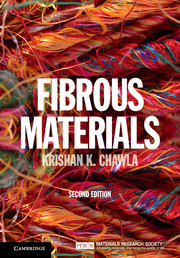Book contents
- Frontmatter
- Dedication
- Contents
- Preface to the Second Edition
- Preface to the First Edition
- Acknowledgments
- 1 Introduction
- 2 Fibers and fibrous products
- 3 Natural polymeric fibers
- 4 Synthetic polymeric fibers
- 5 Electrospun fibers
- 6 Metallic fibers
- 7 Ceramic fibers
- 8 Glass fibers
- 9 Carbon fibers
- 10 Experimental determination of fiber properties
- 11 Statistical treatment of fiber strength
- Appendix: Some important units and conversion factors
- Indexes
- Plate section
- References
6 - Metallic fibers
Published online by Cambridge University Press: 05 June 2016
- Frontmatter
- Dedication
- Contents
- Preface to the Second Edition
- Preface to the First Edition
- Acknowledgments
- 1 Introduction
- 2 Fibers and fibrous products
- 3 Natural polymeric fibers
- 4 Synthetic polymeric fibers
- 5 Electrospun fibers
- 6 Metallic fibers
- 7 Ceramic fibers
- 8 Glass fibers
- 9 Carbon fibers
- 10 Experimental determination of fiber properties
- 11 Statistical treatment of fiber strength
- Appendix: Some important units and conversion factors
- Indexes
- Plate section
- References
Summary
Metals in bulk form are quite common materials and are extensively used in engineering and other applications. Metals can provide an excellent combination of mechanical and physical properties at a very reasonable cost. One of the important attributes of metals is their ability to undergo plastic deformation. This allows us to use plastic deformation as a means to process them into a variety of simple and complex shapes and forms, all the way from airplane fuselages to huge oil and gas pipelines to commonplace aluminum soda pop cans and foil for household use. What is less appreciated, however, is the fact that metals in the form of fibers or wire have also been in use for a long time. Examples of the use of metallic filaments include: tungsten filaments for lamps; copper and aluminum wire for electrical applications; steel wire for use as a reinforcement fiber for tires and in cables for use in suspension bridges; niobium-based filamentary superconductors; and, of course, strings for various musical instruments such as violin, cello, guitar, piano, sitar, etc. Highly ductile metals such as gold and silver can be drawn into extremely thin filaments. Extremely fine filaments of such noble metals have been used for ages as threads in making Indian women's traditional dress called saree.
Let us first review some of the important characteristics of metals, in particular the characteristics that allow metals and their alloys to be drawn into fine filaments, and then describe the processing, structure, properties, and applications of some important metallic filaments. Readers already familiar with the basic attributes of metals may skip directly to Section 6.2.
General characteristics of metals
Metals are generally crystalline materials, although it is possible to produce amorphous metals. One technique involves very rapid cooling rates, say, greater than 106 K s−1. Another technique involves supercooled liquids that fail to crystallize and result in bulk metallic glasses, an important class of amorphous metals. Nevertheless, most common metals are crystalline. Crystalline metals have the following three common crystal structures:
(a) face centered cubic (FCC);
(b) body centered cubic (BCC);
(c) hexagonal close-packed (HCP).
Figure 6.1 shows these structures. Examples of FCC metals are aluminum, copper, gold, silver, and γ-iron (austenite), etc. They are all very ductile and can be drawn to less than 100 µm in diameter.
- Type
- Chapter
- Information
- Fibrous Materials , pp. 123 - 149Publisher: Cambridge University PressPrint publication year: 2016



